|
|
|
Amazon.com International Sites :
USA, United Kingdom, Germany, France
Books about Seven Wonders :
![]() The Seven Wonders of the Ancient World
The Seven Wonders of the Ancient World
What Are the Seven Wonders of the World? and 100 Other Great Cultural Lists--Fully Explicated
In the ancient world there were seven great man-made structures for travelers to see on a world tour. Lists of the so-called seven wonders of the world sometimes varied. The following list, dating from about the 6th century AD, was a commonly used and standard one: (1) the pyramids of Egypt; (2) the Hanging Gardens of Babylon; (3) the statue of Zeus at Olympia; (4) the Mausoleum at Halicarnassus; (5) the temple of Artemis (Diana) at Ephesus; (6) the Colossus of Rhodes; and (7) the Pharos (lighthouse) of Alexandria.
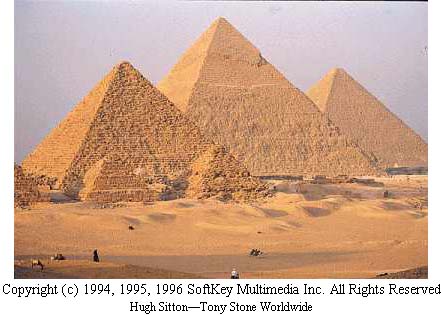
Of the seven wonders of the ancient world, only the pyramids of Egypt have survived in a form that resembles their original condition. The largest of the three, known as the Great Pyramid of Khufu, was made of approximately 2.3 million blocks of stone each weighing an average of 2.5 tons. Located in Giza on the west bank of the Nile River, near Cairo, the pyramids remain one of the engineering marvels of all time. --Hugh Sitton--Tony Stone Worldwide
The great pyramids of Egypt still stand. They were built between 2650 and 2500 BC. Except for parts of the Mausoleum
and of the temple of Artemis, they are the only one of the seven ancient wonders still standing.
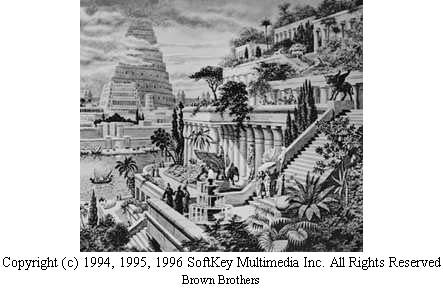
According to tradition, the homesickness of a favorite wife prompted Nebuchadnezzar, king of Babylon, to build the famous Hanging Gardens. Nothing remains of these luxuriant terraces. --Brown Brothers
The Hanging Gardens of Babylon have long since disappeared. They were said to have been built by King Nebuchadnezzar
in the 6th century BC to please and console his favorite wife, Amytis. Great terraces of masonry were built one
on top of the other. On these were planted gardens of tropical flowers and trees and avenues of palms. They were
irrigated by water pumped from the Euphrates River. Nebuchadnezzar and his queen could sit in the shade and look
down upon the beauties of the city. The walls of Babylon were often included with the Hanging Gardens among the
wonders of Babylon. Built by Nebuchadnezzar, they were faced with glazed tile and pierced by openings fitted with
magnificent brass gates.
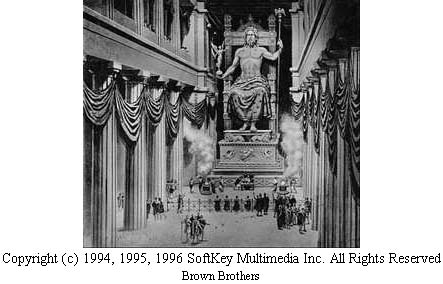
The ivory and gold statue of the Olympian Zeus was perhaps the greatest masterpiece of the sculptor Phidias. It stood in a shrine on the Olympian plain until the early Middle Ages. --Brown Brothers
The statue of Olympian Zeus was erected at Olympia, in the Peloponnesus of Greece, by the great sculptor Phidias
in the 5th century BC. It was a towering structure of ivory and gold, 40 feet high, majestic and beautiful.
After about 10 centuries of existence the statue was destroyed. Our only idea of it is gained from coins of Elis,
which are thought to bear copies of the original (see Zeus).
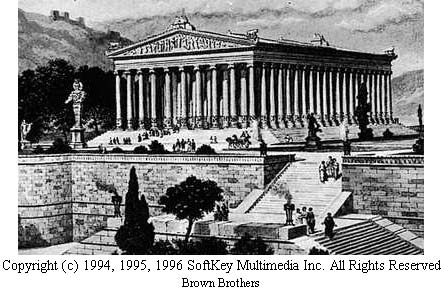
Very little of the temple of Artemis (Diana) at Ephesus remains today. The drawing shows the huge temple as it probably looked in the 4th century BC. --Brown Brothers
Greek colonists at Ephesus, in Asia Minor, built the famous temple of Artemis. The early settlers found the Asian
inhabitants worshiping a many-breasted nature goddess whom they identified with their Artemis (called Diana by
the Romans). They raised a shrine to her, which was rebuilt and enlarged from time to time. The fourth temple was
the one regarded as the wonder of the world. Dedicated about 430 BC, it is said to have been built by contributions
from all the great cities of Asia and to have taken 120 years to complete. This great temple was set on fire in
356 BC on the night Alexander the Great was born, according to tradition. The crime was committed by one Herostratus
merely that his name might be remembered in after ages.
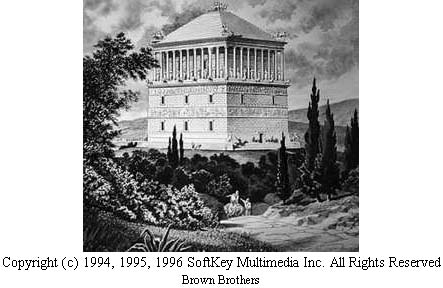
Only crumbling fragments remain of the Mausoleum at Halicarnassus on the coast of Asia Minor. It was raised to the memory of King Mausolus of Caria by his devoted queen, Artemisia. --Brown Brothers
The Mausoleum at Halicarnassus, also in Asia Minor, derived its name from King Mausolus of Caria. After his death
in the middle of the 4th century BC, his queen, Artemisia, employed Greek architects to construct a superb monument
over his remains. It was a great rectangular pile of masonry, surmounted by an Ionic colonnade supporting a rooflike
pyramid. At the apex stood a four-horse chariot in which were statues of the king and queen. So famous was this
structure that the word mausoleum came to be applied to any monumental tomb. Some relics of the original Mausoleum
are preserved in the British Museum.
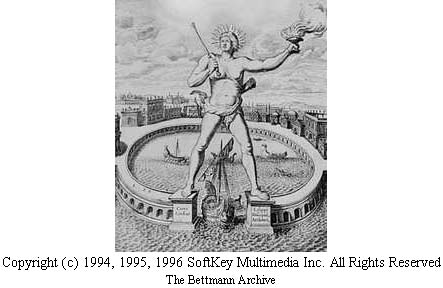
The old engraving of the Colossus of Rhodes is purely imaginary and is based on the legend that the statue stood astride the harbor entrance. --The Bettmann Archive
The Colossus of Rhodes was a great bronze statue, erected in about 280 BC by the citizens of Rhodes, capital of
the Greek island of the same name. It represented their sun-god Helios and was said to be 105 feet high. According
to legend, it straddled the harbor entrance, but it is more likely that it stood to one side. The statue was overthrown
by an earthquake in 224 BC but its huge fragments long were regarded with wonder. Nearly a thousand years later,
in AD 656, a Muslim dealer bought the fragments as old metal and carried them away to be melted down.

For more than 1,000 years the lighthouse known as Pharos of Alexandria guided Mediterranean ships to harbor. Built for Ptolemy II of Egypt in about 280 BC, the lighthouse was severely damaged by an earthquake in AD 955 and disappeared completely by 1500. --Brown Brothers
The Pharos of Alexandria, in Egypt, was the forerunner of modern lighthouses. The name belonged originally to an
island lying off the coast. When Alexander the Great laid out the city he connected the island of Pharos with the
mainland by means of a mole, or causeway.
On the eastern point of the island his successors, Ptolemy I and Ptolemy II, erected a great lighthouse made of
white marble. It was this structure, said to have been 400 feet high, that came to be known as the Pharos of Alexandria.
To ancient and medieval people the number seven had a mystical significance. Accordingly they were much given to
compiling lists involving this number--the seven wonders, the seven champions of Christendom, the seven seas, and
so on. Some of this significance still clings to the number seven, and people continue the harmless pastime of
compiling lists of the seven wonders of the world.
The wonders of the modern world lie not so much in architecture and sculpture as they do in technology. A list
of seven modern wonders compiled after World War I included: (1) radio; (2) the telephone; (3) the airplane; (4)
radium; (5) anesthetics and antitoxins; (6) spectrum analysis; and (7) X rays. The list seems deficient. It fails
to include the automobile, which revolutionized ways of living in the United States, and the techniques of mass
production, which made modern industry possible. A list today would undoubtedly include television, atomic energy,
and artificial satellites as modern wonders.
Amazon.com International Sites :